Trending
Opinion: How will Project 2025 impact game developers?
The Heritage Foundation's manifesto for the possible next administration could do great harm to many, including large portions of the game development community.

Featured Blog | This community-written post highlights the best of what the game industry has to offer. Read more like it on the Game Developer Blogs or learn how to Submit Your Own Blog Post
A look at the release strategy and sales of "Cook, Serve, Delicious!" across PC, Mac and iOS for the first five months.

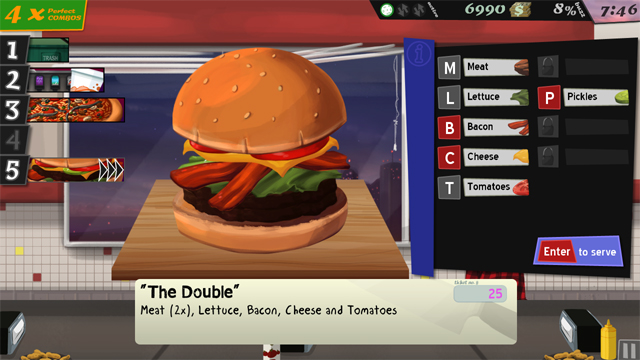
It’s kind of incredible how much the gaming landscape has changed in just less than two years.
Over a year ago I wrote about my experiences selling the Oil Blue (Part 1, Part 2 and Part 3), an indie game that was released on the PC back in 2010 and garnered some critical acclaim but less than stellar sales. Since then I’ve worked on two projects, one that was cancelled after more than a half a year’s work, and the second released last October called “Cook, Serve, Delicious!”, a management game where you buy equipment and foods to fill your restaurant’s menu and cook for people during the business hours of 9am to 10pm. Today I’d like to share my sales and how I got there, where I go from here, the strategies I used in selling the game and what I would and wouldn’t do again.
This is less of a post-mortem in game design and more of what I learned in selling not only my biggest PC game to date, but my first Mac and iOS release as well. Let’s get to it!
Build Up and Buzz
After going through some development hell with a game that just wasn’t coming together for me, despite the terrific art and music that had already been created for the game, I decided to shelve the project altogether and work on something else in the meantime. I had previously sold the Oil Blue in the Indie Royale bundle and had about $10k left to fund my next game (after burning through around 5k on the game I had just shelved). I knew, with a sinking feeling, that this was likely going to be the last game I was going to make if it wasn’t successful. I had already given it a go for years now, but had no real income aside from pockets of sales when the Oil Blue would get some attention here and there. I was making less than a hundred dollars per month on the games I had available, and had most of my income supplemented by my part time job at a coffee shop.
I decided to finally make the game a lot of people had requested I make since 2004: a cooking game that was influenced by the old Japanese PS1 game, Ore no Ryouri. Back in 2004 I made a free fan game based on ONR that was filled to the brim with awful hand drawn sprites and ripped music from the Sims, and yet somehow it really took off with people. The combination of cooking dishes while trying to keep customers from leaving was a fun, chaotic challenge. A few years later I was always trying to get a sequel back off the ground, but it never seemed to come together for various reasons, mainly due to the fact that I had no money to invest in the game. This time, I had the money, and I was going to give it a final go. I knew there was a good concept in that game, and with some polish it could turn out to be quite good. What I really was asking myself was: is it a good enough concept to pin my final attempt at making a good/profitable game?
Work began in March 2012 and the game was formally announced on April 20th. The goal was to have the game hit during the summer so I could take advantage of the slow game news/releases. I was also going to challenge myself in making a weekly blog post that detailed how the game was progressing, my game design strategies, and so on. I’m actually quite proud that I managed to do that, since I hardly ever stick to deadlines or able to stick to a regime for all that long, so woo!
What I was hoping for also with these weekly blog posts was a buildup of interest so that people could get hyped for the release. I was hoping to make a big splash on launch day, and I was shooting for at least $2k in sales on the first few days.
 You can click these Youtube pics to check out the videos.
You can click these Youtube pics to check out the videos.
Platforms and Development
I had always planned for the game to be on multiple platforms thanks to Game Maker Studio, but at the time of development the engine was still in a beta state. I decided to use Game Maker 8.1 in the meantime and release it on PC first, with a port to Mac and iOS once GM Studio got out of beta. I know very little code and Game Maker lets me make any game I really want, so I was in a sense tied to that platform. I didn’t mind as I knew Game Maker inside and out, and as a result I could focus directly on the game making process.
I used the same artist and composer (Sara Gross and Jonathan Geer) as I had for the Oil Blue, as they both had excellent work in the past and delivered right on schedule. I budgeted about $6k for the game and only spent a little bit over: in the end, I spent $5,500 on art and music, with an additional $2,500 on equipment needed to bridge to other platforms, such as an iPad and Macbook Air, as well as a GM Studio license and iOS developer licenses. I don’t include all the time I spent on making the game as virtual money spent, mainly because that’s called an opportunity cost, and I really hate when people argue that they actually lost $60k on a game because their salary for the year would have been $45k in corporate America, etc. Yes, I spent a ton of time making the game, but the day I start measuring my hours put into game making and figure the sum of money I lose by not working for a waged income is the day I need to quit game making because the passion is obviously gone.
Anyways, sorry for the rant there! I had also budgeted about $1k for advertising and press releases, as that was a completely new thing for me so I wasn’t sure how that was going to work out. It was a bit scary, as my previous budget was paltry compared to the money I was spending on “Cook, Serve, Delicious!” despite the fact that even on indie game terms, <$10k on a game is a very low budget. But it sure felt high to me.
One thing that was significant in shaping up the game was an open beta I made publically available with a small amount of game content, followed by a closed beta of the full game. The open beta really showed me some game design flaws that I had previously missed, and allowed me to see from those open beta testers users who were very passionate about making the game better. I invited about twenty of the open beta testers to the closed beta, where they got a full version of the game. I was incredibly paranoid of the game leaking ahead of the release date, but thankfully the game stayed within the forums I released it on.
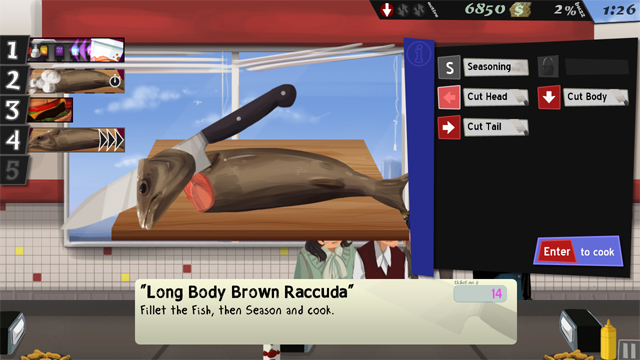
The beta was a great experience, but what I wasn’t expecting was making some tough choices as to how much of the feedback I was going to incorporate into the game. Several users found the game too slow to progress to the next level, so I trimmed the game down by nearly eight hours. It really hurt as I had planned to advertise the 20+ hours of gameplay, but at the same time it was the right thing to do. I’d rather people have a fun twelve hour experience than a mediocre twenty hour one. Lots more fixes were done and there was a great, positive amount of buzz surrounding the game. Or at least, that’s what it felt like.
But as the beta was underway, I knew I wasn’t going to make the summer deadline. And as September loomed, I knew if I wasn’t going to launch before October, then I was going to have to hold the game till next year due to the high profile releases starting mid-October. And that would have been an absolute disaster in terms of income and my personal morale. I worked like crazy and managed to announce a release date: October 5th, on a Friday. It would also be $8.95, as I learned from the Oil Blue that a high price of $15 was something I wanted to avoid. The game was DRM free, same as all my other releases.
The Launch of Cook, Serve, Delicious!
CSD was a different game from the normal cooking casual fare, mainly because it was incredibly hard. This was done intentionally, and I branded the game as “the first Hardcore Restaurant PC Sim” without really knowing if that were true or not. Hey, it sounded true to me! I had no interest in branding the game to casuals, and immediately aimed the game at the more core/indie gamers looking for a difficult challenge. And so, on Friday October 5th at midnight or so, I released the game on PC via my website using BMT Micro.
Right away I realized why games don’t get released on a Friday: if you don’t get any buzz by the end of Friday, you’re next shot is Monday. That’s two days that my game was going to be dead in the water, right after launch. How could I have been so dumb?
Actually, I remember why: because I felt like the people who were going to buy the game were the ones reading my blog since March, and the ones who really loved Ore no Ryomi and had played my previous fan games. I felt that was enough to push me to my $2k goal, a goal that while very short from the $8k I spent, would set me on track.
Well, by Sunday I had made about $250. I was panicking already. The audience that I thought was there was significantly smaller than I had imagined. Very few websites picked up on the game on Friday, leaving me with a dead weekend. I told myself that it would be OK with the Mac and iOS release I was going to work on, which I really felt was a more lucrative market, but it still marked the most depressing weekend I’ve ever had involving my indie game pursuits. I felt like a complete failure.
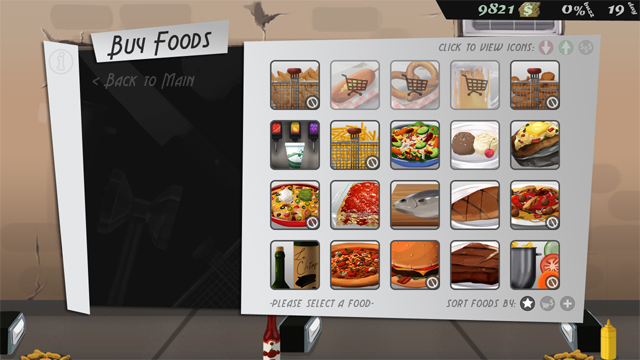
The week following, things got a little better. Rock Paper Shotgun picked up the game and sales grew quite a bit, and by the end of the next week I had hit $900. I changed my goal from $2k in a few days to $2k by the end of the month. I thought that any money I wasn’t able to make to break even I’d make with the Mac/iOS releases.
I was trying to convince myself in all sorts of ways that things would be fine. In the back of my head though, I knew I had blown it. You only get one chance to launch a game, and CSD hit with all the intensity of a marshmallow. I was hoping that my press release via GameBizWire would help get my foot in the door with a few websites, but aside from a few requests from indie sites, there wasn’t much on the radar. It was extremely difficult motivating myself to get through the Mac/iOS ports at this point. Sales were dwindling by the day.
Had that sales trend continued, I probably would have ended my game career. I don’t think I would have had the motivation to go through the Mac/iOS ports due to the fact that Mac was already a smaller audience, and iOS was such a difficult market to break through that it seemed ludicrous to even try since I couldn’t even break through the PC market. I felt like a quitter, but after making two games that I was really proud of design wise and seeing them flounder financially, I had my spirit broken. It was over.
A Giant Bomb
The next week following my game launch, a message on the right bottom corner of my PC screen lit up: an email from Ryan Davis about some promo codes for CSD.
This wasn’t the actual Ryan Davis, was it? Not of the Giant Bomb website that I’ve subscribed to for the last few years and enjoyed with every new Quick Look and podcast, right? No, that can’t be. I paused for a few seconds before opening the email. Sure enough, it was him, asking for some extra press codes/builds mentioned in the press release.
I’d be lying if I didn’t admit to running around the house screaming. But then I realized the game wasn’t exactly a prime candidate for any kind of coverage on Giant Bomb. That’s what I believed anyways, after a rough week and a half of little to no coverage. So I sent some codes over but didn’t think much would come of it.
And then I saw the schedule for the next day over at Giant Bomb: at 2pm, a Quick Look of “Cook, Serve, Delicious!” which is where two Giant Bomb guys play a game for thirty minutes or so. I don’t recall sleeping very much that night.
 Most of the views on GiantBomb are done by their own hosted videos on the GB site, so the view count here is inaccurate to the total amount of people who watched the Quick Look.
Most of the views on GiantBomb are done by their own hosted videos on the GB site, so the view count here is inaccurate to the total amount of people who watched the Quick Look.
Let me tell you what it’s like watching a video of your own game being Quick Looked: pretty damn surreal. I was scared to death that something would break in the game, despite extensive beta testing. I was so excited seeing these two guys that I enjoyed reading/listening to for so long actually playing one of my games. My heart was racing the entire time. Then I watched it about a half dozen more times in the next few days. It felt like such an accomplishment that I felt like it was crazy I was thinking of quitting game making in the first place…well, that is, until I remembered I kinda need to make money doing game development, cause that’s kinda important.
About thirty minutes after the Giant Bomb video went up, sales came in. And they kept coming in all night. Emails would be dispatched to me with every sale, and I could literally refresh my inbox on my iPod seconds after the last email, only to get more sales emails. I had sold 2 copies of my game the day before the Quick Look, and on the day of the video release sold over 140 copies, and even more the next day. It was incredible, and one of the best indie game related days of my life. I finally had the breakthrough I so desperately needed.
If we look at the sales trend for how the game was doing in the first 12 or so days before the GiantBomb Quick Look, I would have made about $1,500 that month. Total sales for the month ended up being $7,400 on both my site and GamersGate/Desura. I had almost broke even before I had a chance to release the Mac/iOS version, something I couldn’t even imagine happening.

Sales graph for PC/Mac- guess which day the Giant Bomb video came out?
Still, I knew it was a fairly big blow not to have the Mac version released at the same time with the PC version. It was mainly due to having to work via Game Maker 8.1, which is PC only, since GM Studio wasn’t quite ready yet. So, I quickly ported the game to Studio and in just a few weeks had a Mac build up and running. Originally my launch press release said the Mac version would come out in November, but I was able to release it on October 28th. I only netted $100 for that month and as of now, have sold around $1,500 for the Mac version alone. I was kind of surprised how poor my experience was with the official Apple Mac App Store, where I thought I’d be making the majority of Mac sales. Not only was the approval times severely slow (nearly taking 14-20 days to approve games and updates), but the sales were nearly nonexistent. One main factor was that the Game Maker Studio build at the time had a glitch that didn’t allow saving for Snow Leopard users. It was a very rare glitch, but led to my one and only review for CSD on the Mac store, alerting me to the bug and warning others of the issue. The GM Studio devs were able to get a fix for me in just a few days, and Apple rushed the update to get it out quickly.
Another problem with the Mac version is that it’s just not very well optimized, mainly due to the different way GM Studio handles files on the Mac that I wasn’t used to. It needs a significant amount of resources to run (optimally 4GB of memory), among other things. This was a byproduct of developing on GM 8.1 first and then porting to Studio, as I didn’t optimize anything for the new engine. I was in a mad dash to get iOS support up and running, and to fully optimize CSD for Mac meant that I’d have to tear down the game completely. Given the sales to date of the Mac version, I did the right thing by choosing to have a simple port, but it still felt a little scummy. It’s a perfectly playable/fine version of the game, if you have a powerful enough Mac to run it.
Tapping into YouTube
Something I didn’t see coming was the ease of which the game could be played and streamed by various YouTube and internet personalities. It had some breathing room during the day for people to chat to their viewers, and then gets immediately chaotic during the “Rush Hour” portions of the day where things just go nuts for one minute. There were people streaming the game for charity events, and some big named YouTube/internet streamers like Northernlion and HAWP giving it a go. Some streamed just to show off their awesome APM skills. It was pretty nuts to watch.

Still, after two months things started slowing down sales and coverage wise, right as I was ready to launch the iPad version of Cook, Serve, Delicious! I was watching various iOS websites and had read dozens of developer breakdowns and strategies by mobile devs, so while I sorta knew what to expect on iOS, I was still very much new to the entire market. I was a no name dev who was about to launch a pricey game that would compete with a ton of other restaurant sim games on the platform, despite my game being significantly different. It was scary, but at the same time I knew I’d have a winner if it found an audience. And I managed to do everything possible to ensure that it wouldn’t.
iOS for Dummies
I had known that Christmas Day is the biggest sales day in the entire year for iOS devs, and I wanted a piece of that pie. I priced the game at $5 for the iPad, with a sale at $3 till January 6th. Giantbomb mentioned the game again in podcasts and even nominated CSD for Best Downloadable Game 2012, which to even be nominated felt like I had won the Oscar. Some major review sites gave me 4 stars and up, with Touch Arcade’s 4.5 star review staying on their front page of the TA App through January. All of this helped to create a lot of sales and buzz for December, and a good thing too, considering how stupid it was to launch in December in the first place.
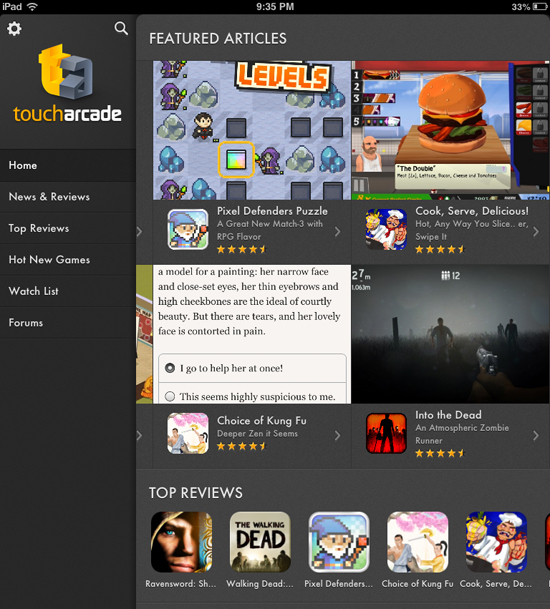
What I knew I didn’t want to do was go down to $1, as the game was new and had no In Game App purchases to help offset the loss. But what I didn’t fully realize was that, sure, Christmas Day was a huge day for app devs…if your game is priced accordingly. I launched during a month where I was competing with endless holiday sales, where huge AAA apps were being sold at just $1, and where major companies would slash their entire hundred plus app catalogue to nearly free. There was no way I could compete with that, and consequently my game didn’t get a Christmas Day boost (it actually sold less than most days). My game was $3 after all, and if I was a kid with a shiny new iPad/iTunes gift card, I’d fill up on $1 apps myself.
Another major fault of mine was the sale till January 6th. I should have never kept the game at $3 for so long- but it was too late. I had already posted how long I’d have the price for, and I didn’t want to upset any users. But sales typically work great at one-two days because you’re on app price watchers websites and get a boost of traffic. After that, you’re basically selling your game at a discount with no disenable difference in revenue whatsoever, since I had to sell more copies to make what I would with a $5 price point. All that holiday traffic could have boosted revenue if I had just ended the sale earlier.
Finally, the last problem I had was the game wouldn’t run on an iPad 1…another byproduct of porting the game from GM 8.1 instead of optimizing it from the ground up. Because there’s no way to prevent iPad 1 users to buy your game, I had to issue warnings in the game’s description. That seemed to work fine, aside from the occasional “HOW CAN YOU LIVE WITH YOURSELF” comments I get from time to time with regards to the game not being on iPad 1. Yes, I actually got that comment.
In fact, it’s kind of a jolt to interact with user reviews on the app store. Some would love the game but would only give me one star until I added a small option or fixed a bug. One user repeatedly gave me one star with every new update saying she liked the game but didn’t like the design choices, and asked herself repeatedly why she still was playing my game for hours. I wanted to punch my monitor. But thankfully the issues were ironed out and the game on the US store currently has 120 4-5 star reviews, with only two negative reviews. That’s pretty awesome, I must say.
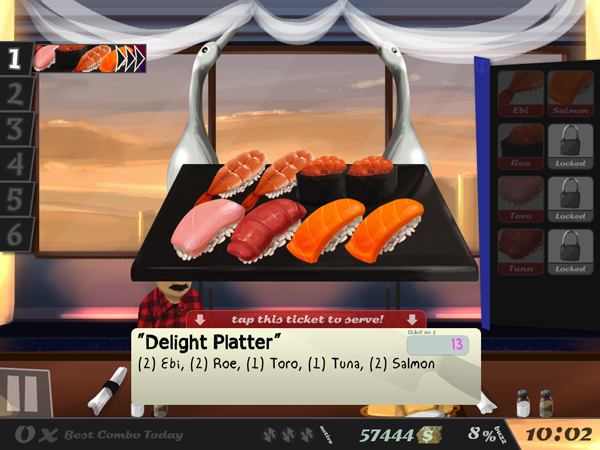
My DLC Take
Because of the ease of patching a game on iOS, I wanted to do something I hadn’t done with any of my games before: offer DLC. I figured this would be a boost of press every time I’d get an update out, and would help sales by offering the DLC for free on PC and as a premium in app purchase on iOS. I spent about $1,800 on new art and music, which consisted of ten new foods and a new gameplay challenge taking place in the Iron Cook Kitchen.
Game design wise, it was a huge success, addressing some of the shortcomings of the game and making it even better than before. Business wise, it would be a huge mistake.
I think the weakest point of the game was when the player was getting from zero to a three star restaurant, which then unlocks new events and challenges, as the one and two star tiers don’t have quite as much going on in terms of new gameplay elements. The new DLC consisted of ten new foods to buy for the restaurant menu (six currently released as of now, with four more in March), and unlike the other twenty foods available would unlock to buy at the one and two star restaurant levels. This helped bridge the gap to the next few restaurant tiers and created new gameplay elements and strategies that really strengthen the game overall, and in that regards it was a big success.
Originally I was going to have the DLC available for free on PC/Mac, with iPad owners buying it at $1.99 per pack. But ultimately I decided to release it for free on iPad as well, as the smaller userbase (about 1,800 at the time when the first patch went out in January) wouldn’t result in very many IAP sales, even if the conversion rate was high. I thought the goodwill gesture would result in more press and ultimately more sales.
What I didn’t think of at the time is just how the game is played. Users can unlock the final restaurant upgrade at around a dozen or more hours, and at that point the game becomes an open ended free play mode, with no other goals to achieve. They will have “beaten” the game. In order for this DLC to be relevant to the user who owns CSD, they’ll need to still be in the progress of beating the game. Because of that, the ability to sell DLC/IAP is hampered. There’s a window in which the user is playing the game and when I can sell them content, and it’s too short to target.
Not only that, but when you think about it, the game is feature complete and selling at $5, a premium price on the iOS market. Once users buy the game at $5, it makes no difference, business wise, whether they play for ten minutes or ten hours…I still make the same amount of money. To create DLC to extend the life of the game benefits me in no way, and crucially ties me up for the next few months as I get all of the DLC finished for iPad so I can move onto the iPhone/Android ports, and then after that having to port the new content to PC and Mac. It was not a smart move, despite the DLC making the game better. My next games will have a better implementation of how DLC can be integrated in a much smarter way, so I won’t be so tied up with porting and developing.
iOS Sales and Results
Since CSD has been released on iPad, I’ve had one more sale at the end of January, decreasing the price from $4.99 to $2.99 for a few days, but that’s been about it. I’m very cautious about creating too many sales, and I don’t want to price the game below $2.99 since there’s no IAP in the game to make up the difference. This is my only game that’s making money after all, so I have to be extremely careful in how I promote it.
Another side note was that I released a demo version on iOS that had about thirty minutes of gameplay before the user had to buy the full version. I had a lot of reviews calling the game a “scam” which was pretty confusing…but after talking with some helpful Touch Arcade forum devs, it turns out calling the game “Cook, Serve, Delicious! Free” was giving the impression that it was the full game for free but with ads, which certainly wasn’t the case. So I changed it to “Cook, Serve, Delicious! Lite” and haven’t run into any problems since. Whoops!
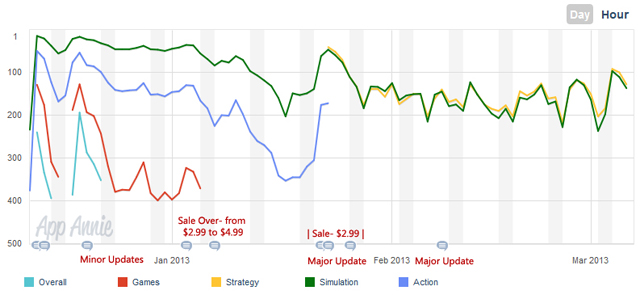
My app ranking on the Top 300 for North America since release through March 6th.
One interesting fact I want to point out is the way the game is charted in the App Store Top 300 Paid Simulation and Strategy charts- it doesn’t quite give the entire picture of how much a dev makes in a day. During parts of Jan/Feb I made more money being near the bottom 300 than being in the top 150. At the same time it does give me a good indication of how sales go during the week, with Tuesday/Wednesday being the best selling days, and Sunday/Monday being the worst. I haven’t cracked the top 75 again since launch through January, but to be on the charts for a few months with my first iOS game is a great start. (I was originally in the Action/Simulation genre listings before switching to Strategy/Simulation in Jan.)
The Totals so Far
The game has been on sale since October 5th for PC, October 28th for Mac, and December 12th for iPad. Here’s how I’m doing in sales so far.
The PC/Mac version has sold a combined $16,200 through March 5th across my site viaBMT Micro, GamersGate, Desura, Amazon and MacGameWorld. BMT, GamersGate and Desura have been nothing short of fantastic to deal with, as they always pay on time and have great tech support. I cannot recommend those three services enough.
(A quick note: I also sell on my website a bundle called the Combo of Amazing, which packages all of the games I have currently for sale, including CSD, into a $15 bundle, which normally would be over $30. That accounted for $3,500 in sales, which is part of that sales total above.)
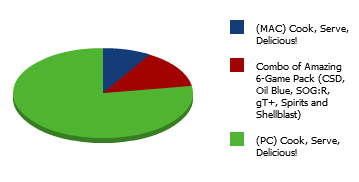
Total sales on the iPad version alone from December 12th through January 31st totaled $10,500, with a projected $2,000-$2,500 for the month of February. Once I have the iPhone and Android port done (should be by April) I’m hoping to make at least $3,500 a month in mobile sales, which would definitely put me on track to have a good year.

iPad sales so far
So, the grand total so far puts me at around $28,000, which is a $17,000 profit after expenses ($2,500 being onetime expenses in getting into iOS/Mac/Android development). For just five months, that’s a very solid figure, but on the other hand I have to admit that would be some razor thin margins for most indie devs. Had I needed a programmer or an additional artist, my profit would be much lower. I saved lots of money and time by doing the game on my own via Game Maker Studio, and it paid off quite well. But had I not been mentioned on Giant Bomb or Northern Lion, I probably would not have broke even on just the $8,500 in expenses. It’s a scary thought that reminds me how lucky/blessed I was that they gave my game a chance.
There are plenty of opportunities for revenue this year with just Cook, Serve, Delicious! I think the new mobile ports will do well, and I’ll likely bundle the game towards the end of the year with one of the major indie bundle guys. I want to return to that shelved game and release it this year, as well as make a major iOS game for release in January 2014, as that seems to be a great empty month that most devs don’t target at all. Look at how much attention was given to Hundreds, one of the few major iOS releases in January.
I’ll likely do another sales article sometime before the end of the year with my experiences in the iPhone/Android market, but I hope this was at least interesting enough to help anyone out there looking into making an indie game. I am finally a full time indie game developer with my game supporting me financially, for the moment anyways. Here’s hoping it’ll stay that way for the months to come!
Read more about:
Featured BlogsYou May Also Like